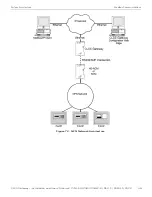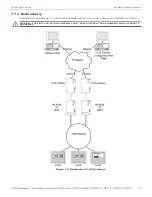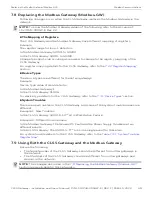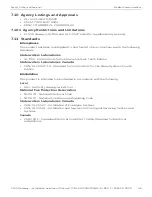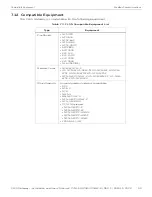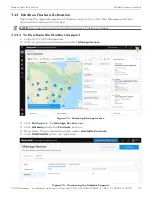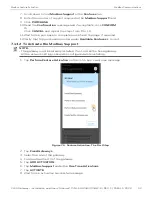
CLSS Gateway - Installation and Users’ Manual | P/N:LS10248-000HW-E | REV. F | FEB/11/2022
60
Analog Values and Trending
Modbus Communications
•
Upon receiving the initialization confirmation, the client can begin polling the analog
points. The client should wait 5 seconds after the initialization request to insure that
the CLSS Gateway has had enough time to get the analog values and load the
registers. Thereafter the CLSS Gateway continues to poll the points. The analog value
in the CLSS Gateway are updated no faster than once every 5 seconds.
• Points are polled if the device is in at least the first level of alarm status. Zero is
returned for devices not in alarm status.
• When a point being polled enters normal status, polling for that point on the NFN
is terminated and the analog value register for that point is filled with zeros.
•
The CLSS Gateway ceases polling the analog points when:
• The client does not make a request for these exact same points over a period
defined in the Modbus Configuration Tool as “Analog Value Time Out”. The
default is 15 seconds.
• The gateway makes a request for a point (or points) that is not
exactly the same as
the initial request
. The CLSS Gateway first sends an initial confirmation for the
new set of analog points, and then begins polling those points at 5 second
intervals.
•
When a 4–20 mA module is in fault, the analog value register for that point is filled
with zeros.
Analog Value Use Cases
Use Case 1:
A client requests analog values from the points L1M1 through L1M10 every
10 seconds.
Result:
The CLSS Gateway sends back zeros in response to the first request for analog
values from the points L1M1 through L1M10. The CLSS Gateway sends back actual
values on the second request from the client 5 seconds later. The CLSS Gateway
continues to poll these devices as long as the client continues to send analog value
requests for points L1M1 through L1M10 at a rate faster than the Analog Value Time
Out.
Use Case 2:
A client requests analog values from the points L1M1 through L1M10. After
10 minutes of polling on a 10 second interval, the client stops requesting analog values
for these points.
Result:
The CLSS Gateway sends back zeros in response to the first request for analog
values from the points L1M1 through L1M10. The CLSS Gateway sends back actual
values on the second request from the client 10 seconds later. The CLSS Gateway
continues to poll these devices as long as the client continues to send analog value
requests for points L1M1 through L1M10. When the client stops polling at 10 minutes,
the CLSS Gateway will stop polling the NFN after the Analog Value Time Out expires.
Use Case 3:
A client requests analog values from the points L1M1 through L1M10. After
10 minutes of polling on a 10 second interval, the client requests analog values from the
points L1M20 to L1M22.
Result:
The CLSS Gateway sends back zeros in response to the first request for analog
values from the points L1M1 through L1M10. The CLSS Gateway sends back actual
values on the second request from the client 10 seconds later. The Gateway continues to
poll these devices as long as the client continues to send analog value requests for the
points L1M1 through L1M10. When the client sends a request for analog values from the
points L1M20 through L1M22, gateway waits till the timeout happens and then the
CLSS Gateway immediately sends back zeros in response to the first analog value request
from these points and starts polling L1M20 through L1M22. The CLSS Gateway only
polls the points specifically requested.
Use Case 4:
A client requests analog values from the points L1M1 through L1M10. After
10 minutes of polling on a 10 second interval, the client requests analog values from the
points L1M5 through L1M12.

